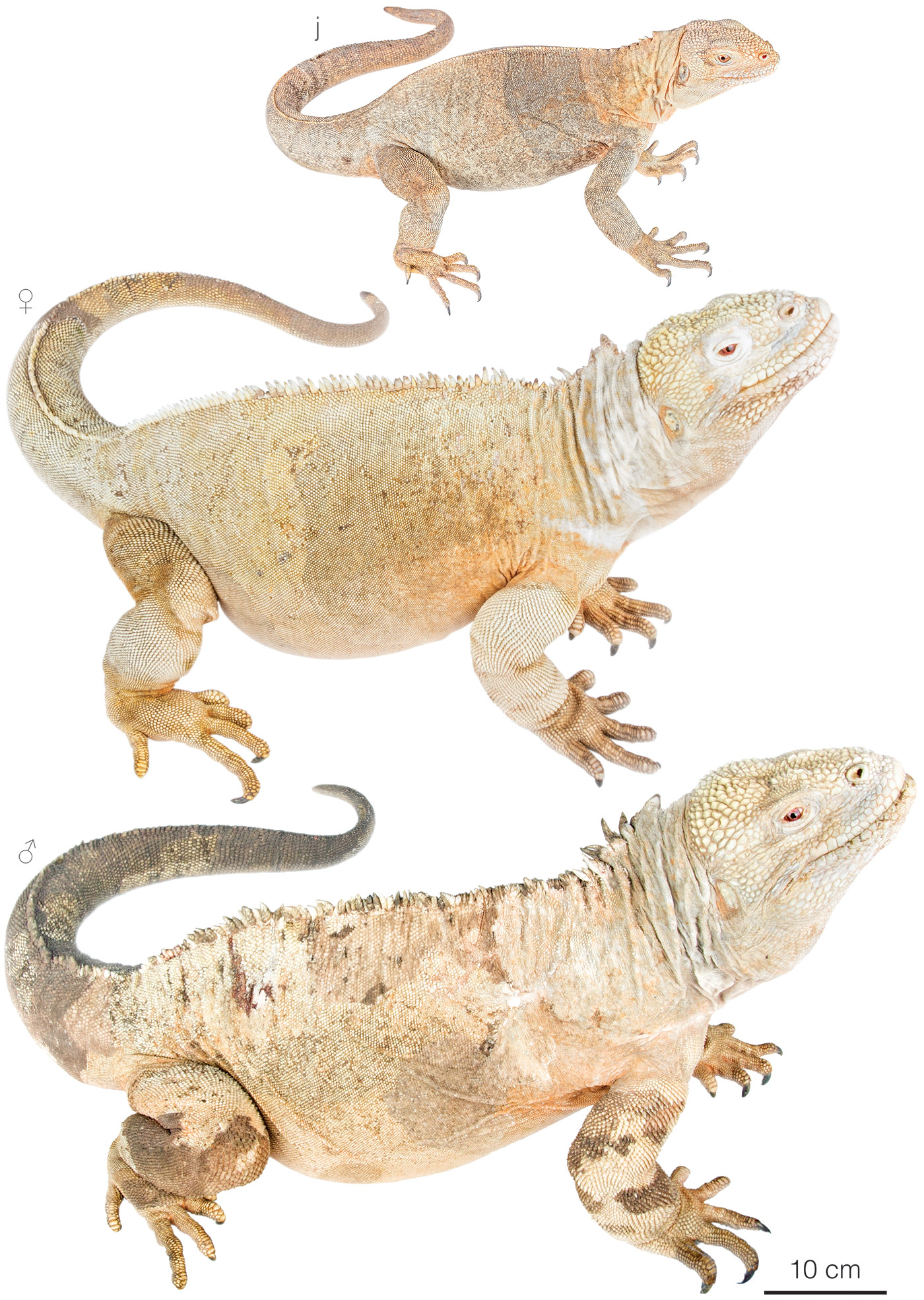Published October 10, 2019. Updated March 8, 2024. Open access. Peer-reviewed. | Purchase book ❯ |
Santa Fe Land-Iguana (Conolophus pallidus)
Reptiles of Ecuador | Sauria | Iguanidae | Conolophus pallidus
English common name: Santa Fe Land-Iguana, Barrington Land-Iguana.
Spanish common name: Iguana pálida de Santa Fe.
Recognition: ♂♂ 114 cmMaximum distance from the snout to the tip of the tail. Snout–vent length=56.4 cm. ♀♀ 100.1 cmMaximum distance from the snout to the tip of the tail. Snout–vent length=49.4 cm..1,2 Conolophus pallidus is unmistakable among iguanas in the Galápagos by its pale cream dorsum lacking contrasting markings or bands (Fig. 1).1,2 Males of this species differ from females by being larger, with a broader head, and a taller dorsal crest.1 Conolophus pallidus is one of two species of iguanas occurring on Santa Fe, but it is the only one on the island dwelling on land. The other species is Amblyrhynchus cristatus, an iguana having a darker coloration, a distinctively blunt snout, and a laterally flattened tail adapted to swimming.1,2

Figure 1: Individuals of Conolophus pallidus from El Miedo, Santa Fe Island, Galápagos, Ecuador.
Natural history: Conolophus pallidus is a diurnal iguana that inhabits the dry grasslands and deciduous forests of Santa Fe Island.1,2 Adults are terrestrial and feed mostly (up to ~56%) on cacti, but also on 25 other native and introduced plant species, including grasses, small trees, shrubs, and herbs.3 They also occasionally consume beetles, centipedes, goat scats, and carrion.4,5 Juveniles are semiarboreal and feed mostly on insects.1,6 These reptiles bask and forage at ground level1 throughout the day whenever temperatures are favorable, and move into the shade to avoid the hot midday hours, sitting on surfaces that have not been heated by the sun. At dusk, they retreat into burrows or under thick vegetation.4 Juveniles are preyed upon by hawks, owls, herons, and snakes (Pseudalsophis dorsalis).2,7 When threatened, these fast saurians run into burrows, vegetation, and crevices; they may also open the mouth aggressively if cornered.1 During the reproductive season, adult males defend territories of up to 20 m2 by bobbing their heads or fighting with intruders.4,7 Between October and November,8 adult females dig holes in sandy soil and lay 2–20 eggs5 that take nearly four months to hatch.8
Conservation: Vulnerable Considered to be facing a high risk of extinction in the mid-term future..9 Conolophus pallidus is listed in this category primarily because the entire population (~7,500 individuals)1 is restricted to a small island where the species could be seriously affected by random, unpredictable events (like droughts and introduced species) within a short time period. The scant iguana sightings in the 1960s–1970s suggests a significant decline of at least 50% in the iguana population three generations ago (52 years). This decline likely persisted until the eradication of goats from Santa Fe Island in 1972.9 Molecular analysis revealed remarkably low genetic variation and richness compared to sampled C. subcristatus populations.9
Distribution: Conolophus pallidus is endemic to Santa Fe Island in Galápagos, Ecuador (Fig. 2). Santa Fe is a small and relatively flat island with an area of 24 km2 and a maximum elevation of 250 m above sea level. The vegetation of the island is dominated by the palo santo tree (Bursera graveolens) and the giant prickly pear cactus (Opuntia echios).

Figure 2: Distribution of Conolophus pallidus in Galápagos.
Etymology: The generic name Conolophus comes from the Greek words konos (=cone) and lophos (=crest),10 and refers to the cone-like scales that compose the dorsal crest in species of this genus. The specific epithet pallidus is a Latin word meaning “pale.”10 It refers to the dorsal coloration, which is paler than the other land iguanas.1
See it in the wild: Individuals of Conolophus pallidus can be seen year-round with almost complete certainty during tourism day trips to Santa Fe Island.
Special thanks to Stephanie Wood and Kelly Geer for symbolically adopting the Santa Fe Land-Iguana and helping bring the Reptiles of Ecuador book project to life.
Click here to adopt a species.
Authors: Alejandro ArteagaaAffiliation: Fundación Khamai, Reserva Arlequín, Ecoruta Paseo del Quinde km 56, Santa Rosa de Mindo, Pichincha 171202, Ecuador. and Juan M GuayasaminbAffiliation: Universidad San Francisco de Quito, Quito, Ecuador.
Academic reviewer: Miguel VencescAffiliation: Technische Universität Braunschweig, Braunschweig, Germany.
Photographer: Alejandro ArteagaaAffiliation: Fundación Khamai, Reserva Arlequín, Ecoruta Paseo del Quinde km 56, Santa Rosa de Mindo, Pichincha 171202, Ecuador.
How to cite? Arteaga A, Guayasamin JM (2024) Santa Fe Land-Iguana (Conolophus pallidus). In: Arteaga A, Bustamante L, Vieira J (Eds) Reptiles of Ecuador: Life in the middle of the world. Available from: www.reptilesofecuador.com. DOI: 10.47051/HEMA6427
Literature cited:
- Arteaga A, Bustamante L, Vieira J, Tapia W, Guayasamin JM (2019) Reptiles of the Galápagos: Life on the Enchanted Islands. Tropical Herping, Quito, 208 pp.
- Márquez CM, Muñoz EA, Gentile G, Tapia WH, Zabala FJ, Naranjo SA, Llerena AJ (2010) Estado poblacional de las iguanas terrestres (Conolophus subcristatus, C. pallidus, y C. marthae: Squamata, Iguanidae), Islas Galápagos. Boletín Técnico, Serie Zoológica 6: 25–43.
- Cano CA (2018) Dieta y uso de hábitat de la tortuga gigante (Chelonoidis hoodensis) y la iguana terrestre (Conolophus pallidus) en la Isla Santa Fe, Galápagos, Ecuador. MSc thesis, Heredia, Costa Rica, Universidad Nacional de Costa Rica.
- Carpenter CC (1969) Behavioral and ecological notes on the Galápagos land iguanas. Herpetologica 25: 155–164.
- Chapman F (2006) Land iguanas (Conolophus subcristatus and Conolophus pallidus). Charles Darwin Research Station Fact Sheet. Available from: http://www.darwinfoundation.org
- Fitter J, Fitter D, Hosking D (2000) Wildlife of Galápagos. Harper Collins Publishers Ltd, London, 272 pp.
- Kricher JC (2006) Galápagos: a natural history. Princeton University Press, Princeton, 256 pp.
- Snell HL, Snell HM, Tracy CR (1984) Variation among populations of Galápagos land iguanas (Conolophus): contrasts of phylogeny and ecology. Biological Journal of the Linnean Society 21: 185–207. DOI: 10.1111/j.1095-8312.1984.tb02061.x
- Gentile G, Grant TD (2020) Conolophus pallidus. The IUCN Red List of threatened species. Available from: www.iucnredlist.org. DOI: 10.2305/IUCN.UK.2020-2.RLTS.T5239A3014028.en
- Brown RW (1956) Composition of scientific words. Smithsonian Books, Washington, 882 pp.